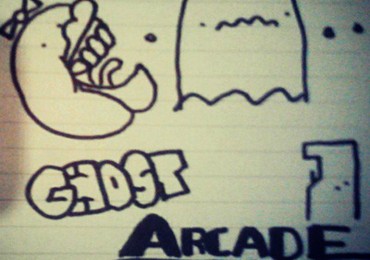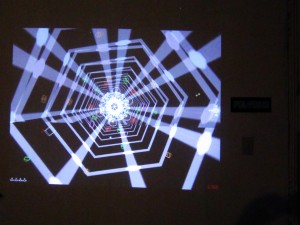A Ghost Arcade In A Festival of Zines and Underground Culture
On October 20, I attended the 2013 Canzine Festival of Zines and Underground Culture at the Bathurst Culture, Arts, Media and Education Centre: an event presented and covered by Broken Pencil Magazine. And here is where a little more background information is order. A zine is usually a self-published work of original or “borrowed” text with images that are usually printed and arranged from photocopied material (though sometimes they are hand-drawn as well), while “underground culture” can generally be seen as an umbrella term for art, politics, philosophies, Do-It-Yourself crafts and games that focus on topics generally not given the same attention by “mainstream culture” such as many of the above including fanfiction, sexuality, and ephemera.
Remember the word ephemera: because it’s integral to the idea behind the Ghost Arcade.
I already feel as though I am doing the Canzine Event–which spans the cities of both Toronto and Vancouver–very little justice in my above description. For me, that word ephemera is what comes into play: transitory material and supplements that do not always survive the light of another day. The truth is that I wanted to cover this Event for G33kpr0n. I wanted to talk about how important it is, and focus on some of the glimmering gems that I found among the newspaper-like quality of zines, the Robert Crumb Underground Comix-like drawings, Game of Thrones colouring books (with presumably wide lines for lots and lots of red), abstract Nuit Blanche-worthy art, erotic Choose Your Own Adventure Books, the presence of the Toronto Comics Art Festival, vendors with small tiny cautionary stories about loving someone who does not love you back, chocolate-chip cookies, and so much–oh so much–irony. It’s like a 21st century Portobello Road of sass, cuteness, and the just plain weird: but at the same time it’s also a community where friends can meet, eat $10 vegetarian meals and even make a profit or so as a vendor in a laid-back atmosphere of general good will. But this is a very generalized description and there isn’t very much that I can add beyond it.
Instead, all I can focus on is the Ghost Arcade and how, in my mind, it ties everything–and all of this–together.
I actually heard of it online first and knew that Broken Pencil had specifically gone out of their way to ask Skot Deeming (aka mrghosty) to bring the Ghost Arcade to the Festival: as if it hadn’t already been there … at least outside of its spirit. Skot is an artist, curator, researcher and doctoral student at Concordia University as well as a curator for Team Vector and co-director for its Vector: Game and Art Convergence symposium: which is appropriate given that Skot himself examines how video games influence culture and create various hacker subcultures. This focus determines the Ghost Arcade and, in some ways, draws on the very spirit of the Canzine Festival.
It was the first room I went into as I entered the festival. I didn’t know what to expect and I admit: I was surprised. The room’s blinds were drawn and there were devices with pieces of paper under them. The items ranged from PlayStation Portables, to Gameboys, all the way to miniature laptops. I will also admit that, at first, I was disappointed. Here I was expecting to find game cabinets like the Torontrons painted in white or ethereal colours with strange and unusual pixilated games from a lost time. But I looked at the games themselves and their descriptions within the dim light of the room and the screens that still glowed.
And this is where the power of the Ghost Arcade began to exert itself on my mind. I found a prototype hack of Resident Evil 2–known as Resident Evil 1.5–and a NES or Famicom version of Final Fantasy VII on a hand-held device. There was Somario: which was a game featuring Mario with all of Sonic the Hedgehog’s running and spinning moves. There was also the strange and arcane Polybius game that supposedly drove people insane from a singular black arcade cabinet in the 1980s: in which you as the player must align the environment around you so that your ship–which you can’t move–can shoot the targets properly and not get destroyed in the process. In addition, there was a Marvel Vs. Capcom remix game: a hacked game that plays Michael Jackson’s songs in lieu of the original programmed soundtrack, a Nintendo 64 controller reprogrammed and modified to play games as its own entity–in much the same way H.P. Lovecraft’s Herbert West experimented on dead body parts to make them into singular and independent creatures–and a Pokemon Black game inspired by the creepypasta of the same name: another Internet urban legend made manifest by the will of its hacker-fans.
Polybius at Ghost Arcade. Do you feel the madness? Photo credit: Skot Deeming.
Did I also mention that at least one Nintendo game was on a PSP and there were just as many hardware modifications as there were software alterations? This is only part of the point that Skot Deeming is trying to illustrate–a perspective that Anna Anthropy in her book Rise of the Videogame Zinesters also shares–in which video games have evolved from being products of an industry to narratives that inspired many childhoods from the late 70s onward the point of being appropriated by hackers acting as programmers, artists, and storytellers. Zines themselves are also historically known as being part of the punk subculture: in which–in addition to punk and grunge music of the late 80s to 90s–zines, remixes, and other counter-culture or DIY artifacts were–and are–crafted. What I’m trying to illustrate is that all of this is tied together: that Skot partially looks at how some of us as players have taken something that was once a consumer product–something considered ephemeral and made for short-term fun–and made it into something beyond the nostalgia factor: made it into something new.
But Skot goes further than that. The Ghost Arcade–in which he curates all these games and customizes their strange bare-bones Frankensteinian hardware–is a one-day event that displays games that not only should have been short-lived and brushed away in the daylight, but also should never have existed at all. And yet they do: just like ghosts are reported to be. And now, think about what a Ghost Arcade is. An arcade is defined as a succession of arches supported by columns that sometimes enclose a particular space. But what happens when these arches are ideas and the columns are the stuff of daydreams and nightmares made manifest in pixels and old newspaper?
And that, in the end, is what the Ghost Arcade represents to me. It symbolizes the very soul of the Canzine Festival: a one-day market and celebration of media that can easily be modified and thrown away, but whose ideas continue to linger on and find new life in places beyond traditionally established organizations. They exist in unique goings on. They get recycled and modified. They exist in people and every-day individuals.
It’s strange how things come together. A little while ago, I examined the origins of a Slovenian art and music 1980s movement known as FV Disko on my Mythic Bios: and not only did they have punk, DYI, collage, pastiche, and experimental influences but they also used photocopiers and appropriated technology from older authority structures and industrial products to make new art. And after attending the Festival this weekend, I can see where social change and art interlap and it’s just as autumnal, fleeting, modest, and beautiful as an exchange and a celebration of Geeks and ghosts. In fact, and as far as I am concerned, life itself can be defined a Ghost Arcade.
If you are interested in knowing more about Skot Deeming’s Ghost Arcade, please feel free to read his Blog on the subject: in which he describes the importance of saving transitory and ethereal human experiences in pixels far better than I ever could.









